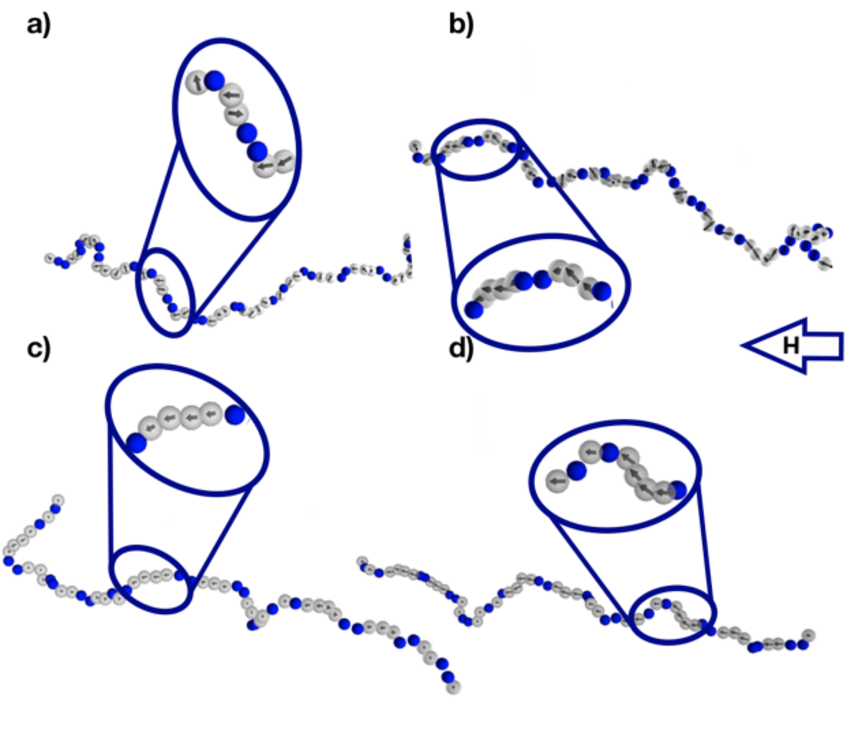There has been a growing recognition of the potential of responsive coatings whose structural and rheological properties can be controlled by means of external magnetic fields. Among others (i.e. magnetic gels, elastomers), coatings, consisting of a polymer matrix with embedded magnetic colloidal particles, that can be attached as thin layers to the surface of solid substrates, fit well within this class. However, conventional synthesis approaches provide limited control over the structure of the polymer matrix. Our approach for the construction of smart materials with sophisticated magnetic response by embedment of magnetic micro- or nanoparticles (MP’s) within permanently cross-linked structures (i.e. brush structures), such as polymer arrays or networks, is the cutting edge of such research, with great potential for technological applications. Magnetic filaments are micro or nanoparticles, pre-crosslinked into polymer-like linear chains. In this way, one could obtain a thin film coating that could extend the broad set of applications of smart polymer brushes to highly magneto-respon- sive systems.Recently, we proposed a build of a magneto-responsive coating with a well defined microstructure, analogous to the one corresponding to a polymer brush, but at a supra-colloidal scale, based on the use magnetic filaments. This has potential applications in magnetically controlled filtering and flow control elements in micro-fluidic devices.

Research Scope
Our project, aims to encompass, in its entirety, synthesis and fundamental understanding of Nanoscopic Magnetic Filaments (MFs) and MF based superstructures, in order to pave way for the development of improved magneto-responsive materials and new applications. Firstly, our goal is, accompanying our international partners, to push forward a novel synthesis technique, that will provide a higher degree of control over the properties of MFs. Our approach should overcome the limitations of currently available methods, reduce the difficulty of synthesis for surface grafted systems while yielding MFs with significant flexibility of the filament backbone. We aim to model and precisely characterize this system, along with fully determining and formulating the production dynamics and mechanisms, recognizing, characterizing and quantifying characteristics and regimes that make our MFs promising building blocks of complex, nanostructured magnetic materials and magnetic fluids with improved properties.
Secondly, we want to understand the requirements and critical points in designing and appropriating MFs in industrially and bio-medically applicable superstructures. We plan to reach and define desirable responsiveness and behaviour criteria based on extensive hydrodynamics simulations of our systems, both in static and AC magnetic fields. We scrutinize the interplay of the internal structure and properties of the building blocks, (i.e. magnetic nature of nanoparticels and micro-structure of filaments), and the dynamics of the overall superstructure systems, with multiple levels of complexity, ranging across:
- Nanoscopic Magnetic Filaments and their suspensions
- Supramolecular Magnetic Filament Planar Brushes
- Spherical Brushes based on Nanoscopic Magnetic Filaments
- Janus particles based on filament based propellant brushes
Finally, we implement our models in a highly efficient, modular and parallel computing appropriated code, which makes our research highly transparent and immediately available to the larger science community, and should enable a seamless inclusion and combination of the phenomenology and infor- mation we bring to light during our research, with further biologically and chemically bound conditions.
Relevance and Expectations
- Chain-like aggregates of MP’s have been shown as promising candidates for the design of recording media and sensor systems, biomedical materials and tuneable photonic crystals. Initial need for synthesis of MF systems arose for magnetically controlled microfluidic implementations. In particular, the main application explored to date, is their use as magnetically actuated artificial cilia, which can be used to create micro-swimmers for future, externally controlled drug delivery devices.
- It is also possible to create magnetically actuated microfluidic pumpers and mixer, a function essential for lab-on-chip devices and other microfluidic systems. Some investigations have been made into MF implementations as micro-mechanical sensors, as well as in the context of contrast agents for magnetic resonance measurements. Here, they have great potential, due their higher sensitivity to magnetic fields, compared to currently used agents.
- More generally, MFs are promising candidates to replace conventional magnetic fluids, in any application that may benefit form the enchantment of magneto-rheological responsiveness. MF use can make design of magnetically controlled microfluidic valves and micro-filter devices significantly simpler. In fact, increased magnetorheological responsiveness might find uses for magnetically controlled dampeners or polishing systems.
